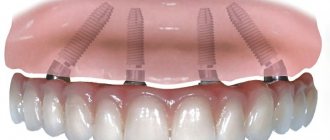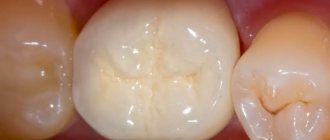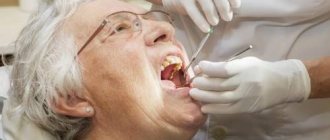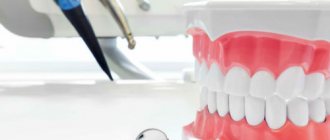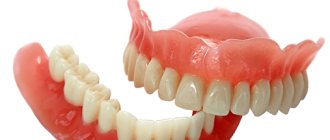Sooner or later, almost all people face the need to have dental prosthetics. Of course, it would be better if such a moment came as late as possible, but if problems with the dentition have arisen, they need to be resolved quickly so as not to cause irreparable harm to one’s own health. What dentures are best to put in if it’s time to “surrender” to the hands of an orthopedic dentist? To make a good choice, you need to know what dentures are in general and in what cases they are usually used.
Why can't we leave everything as it is?
When a person loses a tooth in the smile area, he usually tries to restore it - but with chewing teeth that are not visible, the situation is different. Many people think that if one chewing tooth is lost, then nothing bad has happened - the rest are in place, which means they can chew.
Each tooth in our jaw carries an important functional, and not just aesthetic, load. If the tooth is not restored, negative consequences will inevitably occur:
- improper distribution of the chewing load will lead to gradual destruction of the teeth next to the defect - after all, they will have to work for themselves and for the lost tooth;
- bone tissue atrophy will occur due to the fact that there is no load during chewing;
- Bite defects will appear - if a tooth has been missing for years, then its row neighbors gradually begin to shift towards the empty space;
- chewing food will not be of sufficient quality, which over the years will lead to the development of problems with the gastrointestinal tract;
- bite defects will negatively affect the functioning of the temporomandibular joint, which will provoke neck pain, headaches, discomfort and pain when opening the mouth or chewing, even insomnia;
- Diction problems will appear.
Indications for removal along with the root
No dentist will remove a tooth just like that, since each one is important for the normal functioning of the dental system - doctors still try to preserve them. To do this, fillings or restorative inlays, crowns, pins and stump inlays are placed in the root canals. So is it necessary to remove tooth roots before getting dentures? Yes, indeed, sometimes situations arise that removal is the only option, otherwise complications are possible - up to infection of the jaw bone or loss of all units in a row.
Let's consider cases when deletion is indispensable:
- the presence of vertical cracks in the roots,
- irreparable perforations in the root wall or in the bifurcation area (the place where the roots begin to branch under the crown),
- presence of a piece of dental instrument in the root canal that cannot be removed,
- chipping of the crown deep under the gum: in this case, placing a filling or core inlay may be problematic due to the damp environment around - such a restoration will not last long,
- the presence of neoplasms under the roots (cysts, granulomas) that cannot be eliminated without removal,
- destruction or complete dislocation due to injury: blow, bruise, gnawing something hard,
- inability to go through root canals with an instrument due to their non-standard shape,
- osteomyelitis of the jaw: if osteotomy (cutting off) of pathological areas of the bone is required,
- severe loss of bone and gums against the background of the late stages of periodontitis and periodontal disease: here the teeth become very mobile, and tartar builds up along the roots - an infectious focus arises, which leads to inflammation and toxic damage to the surrounding tissues (gums and jaw bone).
But how to place a tooth if there is no root?
The main goals of prosthetics are to return the patient to the ability to chew food normally, restore the aesthetics of a smile, and prevent further tooth decay due to chewing overload. Here are 3 main ways to insert a tooth:
- removable prosthetics
- making a prosthesis from nylon, acrylic, silicone, Acry Free material; - bridge prosthetics
- the classic technique involves grinding two adjacent teeth with a defect, which will be used as supports for a prosthesis that replaces a lost tooth. It is also possible to install a bridge on implants; - installation of an implant
followed by loading with a crown.
Sometimes patients ask if it is possible to grow a tooth in any way without a prosthesis? Alas, no - if a tooth is removed or lost along with the root, then there is literally nothing to build up. The methods of tooth extension, which we also talked about, are effective only in cases where there is a root and some volume of the crown has survived.
Restoration of premolars and molars
When restoring chewing teeth, there are certain features: the structure must be resistant to any mechanical stress.
Most dentists recommend using the following methods for this:
- Implantation. When restoring the masticatory group, there are some disadvantages: the procedure is two-stage. The process takes a long time, but is popular. Bone grafting may be performed first.
- Clasp prosthesis. This is a base that looks like gum; crowns are subsequently installed on it. Recommended for use if there are no chewing teeth on both sides of the jaw. The main feature is that the load is distributed evenly; if other teeth have poor stability, this is important. But there are also disadvantages; if you want, you won’t be able to install ceramic crowns.
- Removable prosthesis. The option is considered one of the most budget-friendly. Nylon or acrylic dentures can be used.
Plastic crowns
As you can see, all recovery methods are different and have both disadvantages and advantages.
Removable dentures
For centuries, dentists have been solving the problem: if there is no root, how to make a tooth? The first option, which has been around for thousands of years, is removable dentures. They were found during excavations of Egyptian tombs and in the territory of the Mayan Indians, so this is one of the most ancient methods of restoring teeth.
What are its advantages? Firstly, it is fast - making a prosthesis takes from 3 to 7 days, depending on the complexity of the work; secondly, it is inexpensive compared to bridges or implants. Modern materials for removable dentures make it possible to create structures similar to natural teeth, but they still have disadvantages:
- service life even with careful care is about 5–7 years;
- constant risk of prosthesis falling out and the need for additional fixation;
- the prosthesis does not stop bone atrophy;
- does not allow the chewing load to be evenly distributed;
- sometimes causes diction defects;
- there is a risk of allergies to acrylic, nylon, silicone and other materials.
Removable prosthetics are now being used if there are absolute contraindications to the installation of bridges or implants, or as a temporary measure while the patient waits for a permanent prosthesis to be made.
Criterias of choice
The prosthetic method and material depend on the condition of your teeth. Only a dentist can provide this information after examining the oral cavity.
The main points that the doctor relies on when choosing a prosthetic method are the following:
- The condition of the mucous membrane in the oral cavity. In the case of periodontal disease, prosthetics are not recommended.
- How are the crowns positioned: is there crowding, reversal, etc.
- Is the root system stable?
- To what extent are the crowns destroyed? If units cannot be restored with composite materials, an anatomical inlay will be used to reconstruct the site of failure.
- What size and area does the defect occupy? In this case, a single crown, dental structures or implants can be used.
- Where is the area being restored? It is based on this indicator that the material for future crowns is selected.
You can hide some imperfections with veneers or lumineers.
The materials have been developed so successfully that dentists can restore teeth, taking into account all physiological characteristics. The price range varies and depends on many factors.
Interesting! Dental reconstruction is a recommendation and the final decision rests with the patient.
Bridges
The good old classic that dentists offer when they see that a root is missing. Bridges do not need to be removed from your mouth every day to be cleaned, unlike removable dentures, they will last 10-12 years with proper care and are much better at restoring chewing function. Modern materials are quite effective at restoring a beautiful appearance to a smile. The price and production time of such a prosthesis is higher than that of a removable prosthesis, but lower than that of an implant.
What are the disadvantages of this technique?
- With classic prosthetics relying on your own teeth, due to the uneven distribution of the load during chewing, the supporting teeth under the bridge gradually begin to collapse.
- Bone atrophy also does not stop.
- The denture requires special cleaning products - pipe cleaners, brushes, etc., otherwise food debris and plaque will accumulate under it.
- The implant-based method is not always possible - if one tooth or two in a row is lost, the doctor will not remove adjacent healthy teeth in order to put implants in their place.
Surgical stage
Purpose: preparation of the site for implant installation, implantation of an artificial root, formation of the correct gum contour.
Under local anesthesia, the implantologist sequentially performs the following 4 surgical procedures:
Dissection of gum tissue
To gain access to the bone of the lower or upper jaw, the doctor makes a small incision in the gum and removes the flaps.
Formation of a landing channel for an implant
Using a surgical template, the doctor drills a channel of the required depth and width into the spongy tissue.
The doctor measures the resulting depth of the canal in the bone tissue and compares it with the required value.
Performs smooth boring of the channel to the planned width. Drills of different diameters are used sequentially.
Fixation of titanium rod
An implant is placed in the hole.
First, the artificial root is implanted using an electrical device. It is then screwed in by hand until it matches the edge of the bone.
The implant is closed with a temporary plug.
Gum suturing
The edges of the incisions are sutured to close the plug.
After the implant has healed (3-4 months on the lower jaw and 4-6 months on the upper jaw), to give the gum an aesthetic contour, the plug is removed and a gum former is placed.
A maximum of 14 days after installation of the gum former, it is replaced with an abutment - the connecting link between the implant and the orthopedic structure.
A temporary coping is placed on the abutment for taking impressions.
Dental implantation
A provocative question: is it possible to put a crown on the root of a tooth? Yes, if this root is an artificial implant made of titanium alloy or even zirconium. Installing an implant solves almost all problems with tooth loss:
- stops bone atrophy;
- completely restores the natural distribution of chewing load;
- no damage to neighboring teeth;
- excellent aesthetic result;
- implant service life - from 25–30 years to lifelong;
- a large number of possible options for creating crowns - ceramics, metal-ceramics, solid zirconium or zirconium with ceramic lining;
- ease of care, no different from the hygiene of natural teeth.
When an alternative to dental implants may be needed
Not everyone can get implantation. Contraindications for surgery:
- mental pathologies;
- immunodeficiency states;
- cancer;
- decompensated diabetes mellitus;
- rheumatism;
- problems with blood clotting;
- diseases of the central nervous system;
- diseases of bone tissue;
- inflammatory processes;
- severe heart pathologies;
- renal failure;
- increased sensitivity to antiseptics;
- age up to 18 years.
The list of contraindications varies depending on the implantation method. In addition to the restrictions on installing titanium roots, implantation has other disadvantages:
- relatively high cost of treatment;
- risk of implant rejection;
- the likelihood of damage to the maxillary sinuses (with prosthetics in the upper jaw row);
- complexity of the operation (the integrity of soft, bone tissue, nerve endings and mucous membranes is damaged - postoperative swelling and pain occur).
What to choose?
What to install if there is no root - a removable denture, a bridge or an implant? The dentist will select prosthetic options based on the condition of the oral cavity and the presence of relative or absolute contraindications. However, today doctors most often offer implant prosthetics. It has only two disadvantages compared to other types - a higher price and a longer period of prosthetics with several stages. However, this is compensated by excellent, long-term and predictable results. In addition, implantation technologies are constantly being improved; there are already techniques and implants that can significantly reduce the time of prosthetics.
Installation of prosthetic anterior teeth on the upper and lower jaws
The use of dentures for the lower and upper anterior teeth is almost the same from a practical point of view. The difference may lie in the fact that the installation of dentures for the upper teeth requires more attention from the dentist, since the upper jaw is somewhat less well supplied with blood than the lower jaw, hence healing here will take a little longer. And also, when a person smiles, the front teeth are the first to be seen from above, so it is necessary to pay more attention to the aesthetic side of prosthetics.
What determines the cost of prosthetics?
Prices for installing dentures and artificial crowns depend not only on the cost of the structures, but also on the following indicators:
- Type of medical institution – public or private.
- The level of material equipment in dentistry and the availability of experienced, highly qualified personnel.
- The type of material used to make an implant or crown.
- Manufacturer of the product or material for its manufacture - domestic or foreign.
- Additional costs due to the need for preliminary treatment of oral diseases.
- The cost of the dentist and dental technician to prepare, manufacture and install a crown, implant or bridge.
Prices for crowns, implants, bridges and other types of prostheses can vary greatly in different clinics. You can only find out how much it costs to insert one tooth from your attending physician. Since the websites of dental clinics most often indicate price ranges or their minimum values.
Write a comment
Milan
December 20, 2015 at 10:52 pm
I first learned about plastic dentures on this site. I don't know what they really look like, but in the photo they look quite normal. Of course, metal ceramics are the most common, but in terms of beauty and aesthetic appearance, naturally, porcelain is the best known. Zirconium dioxide is also new, but it looks very realistic in the picture presented.
Elena
January 25, 2016 at 11:47 pm
Yes, getting sick is very expensive these days. It is necessary to treat teeth only at the stage of a problem, such as caries, for example. If you don’t cure a small black spot in time and don’t put a filling on one tooth, then over time you will have to treat two. and this is still good if you simply treat it, but when you already need to remove the tooth, it’s already completely sad. Personally, I go to the dentist every six months, it’s better to undergo prevention than treatment
Zhanna
November 25, 2016 at 6:36 pm
Well, yes, of course, prevention. My teeth didn't hurt at all. And one day, closer to autumn, I went to work in the morning during the summer, and returned home in the evening during the cold autumn. Lightly dressed, she was frozen to the bone. My throat hurt so much that it even began to swell. After three days of severe ear pain, an ambulance was called. An x-ray was taken at the hospital. Result: two teeth were pulled out. The third was treated. Then he had to be removed too. And the question of prosthetics arose. Now I will know what it costs and what is best to install.
Tatiana
February 7, 2022 at 6:54 am
I learned a lot from the information presented. At the moment, the question of choosing a dental implant has arisen, since I recently lost my front tooth. Prices, of course, are steep, but what can you do, going without a tooth is not an option, but now I know more, and I will build on the information I read on the site. You will also need to consult with your doctor which material is best to choose.
Kirill
October 4, 2022 at 10:32 am
My wife had a piece of her front tooth fall off, she went to the central dentistry, and they told her that she needed to get a crown. And then a friend advised her to go to a private one, and so, they said there were no problems and installed veneers. It turned out inexpensively - about 5 thousand for everything. Done in 1 session.
Anna
October 5, 2022 at 6:22 am
I am 56 years old, I wear a removable denture, it rubs all the time, and I have a lot of problems with care. My daughter promised to pay for permanent prosthetics for the entire jaw, so I’m preparing for treatment. What is better to choose, to use several existing teeth for fastening or to remove them and make a prosthesis for the entire jaw on implants? Why I doubt it, these teeth are already worn out and I’m afraid if I leave them, the work will quickly become unusable.
Ulyana
October 8, 2022 at 11:51 pm
I want to put a stump inlay so as not to make an implant; I have a root left from the third tooth on the upper right. The doctor said you can either remove it and do an implantation, or put metal-ceramics on the stump inlay. I don't know which is better. Of course, a crown will be cheaper in price, and there will be less pain, as I understand it, but I’m very afraid of dentists, but what if it doesn’t last long and in a couple of years I’ll have to get an implant? Please advise anyone who has experienced this type of treatment.
Is a compulsory medical insurance policy sufficient to obtain a quota?
The quota in orthopedic dentistry is the amount of qualified and high-tech medical care that a person can receive if he needs prosthetics. In this case, assistance is financed from the state budget. But not everyone can receive it, but only a person who meets certain criteria. Just having a compulsory medical insurance policy (compulsory health insurance) and a passport of a citizen of the Russian Federation is not enough here. Documents confirming social status, income or special contribution to the welfare of the state are also needed - the full list will be given below.
